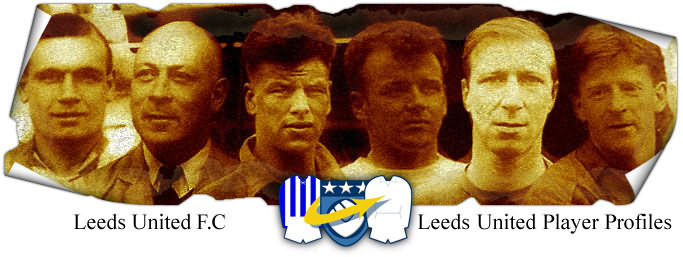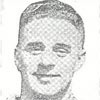

Fowler: Alan
1927-1934
(Player Details)
Centre Forward
Born: Rothwell Nr Leeds: 20-11-1911
Debut v Birmingham City (a): 11-02-1933
5’6” 10st 6lb (1928)
Fowler played for Rothwell Schools and joined United’s groundstaff from Whitehall
Printers in November 1927. He was loaned back to his old club and to Brodsworth Main, but
United knew they had a potential star. A former schoolboy international he understudied
the likes of Tom Jennings, Charlie Keetley and Arthur Hydes and maintained a good scoring
rate in the senior side. In May 1934 he went to Swindon Town, hoping for regular League
football, and his tricky dribbling and accurate shooting brought him plenty of goals. After
only fifteen games in almost seven years at Leeds he made a fine impression as he scored
in his first game for his new club and went on to score sixty-seven league goals in one
hundred and seventy-three games, and score eight goals in eleven F.A. Cup games, and eight
goals in ten appearances in the Third Division Southern Cup, a total of eighty-three goals
in one hundred and ninety-four peace-time games for the Wiltshire club. In a Division
Three South Cup match against Luton Town on 25th September 1935 he scored four goals,
including a hat-trick in the first six minutes! It is believed to be the fastest in the
club’s history. He made his debut on 25th August 1934 in a 3-1 home win over Queens Park
Rangers. He went on to be top scorer in three seasons, and scored twice in the only game
of the 1939-40 season when Swindon drew 2-2 with Aldershot on 2nd September 1939, in
Fowler's and the club's final peace-time game. During the Second World War Fowler scored
eighteen goals in twenty-eight War-time League games and one goal in two War-time Cup
appearances, a total of nineteen goals in thirty war-time games, all in the 1939-40 season,
as Swindon did not play any further War-time football until after the War had ended in the
1945-46 season. He ranks twelfth in the all-time list of Swindon goalscorers, netting one
hundred and two goals in two hundred and twenty-four appearances in all games that he
played for the Robins. There is little doubt that had the Second World War not intervened
his record would have been even more impressive. Dick Mattick, the Swindon Town club
historian, describes him “At just 5ft 6in, Alan was small for a striker, but he made up
for his lack of inches with speed of thought and good ball control. He was no slouch in
the air either, as many of his goals came from headers, where his sense of timing enabled
him to beat much bigger men.” As Swindon did not participate in the War-time League after
1939-40 season Fowler played as a guest for several clubs during the war, when Army duties
allowed, playing once for Queens Park Rangers and six times for Watford in the 1943-44
season. Fowler briefly returned to Leeds to play wartime football, but did not play for
Leeds United. As he and his wife lived in Swindon and with his parents also now living
locally (at 7 Leicester Street), he returned to the area to enlist, and found himself in
the Dorsetshire Regiment. He rose to the rank of Sergeant in the Dorset Regiment.
Footballers were often maligned as being PT instructors and not properly trained to be
frontline troops. Fowler was one such PT instructor and was not included in the forces
required for the initial D-Day landings at Normandy. But the Dorsets were going to be
right in the thick of it as the allies tried to make progress and gain a foothold in
Europe. Fowler had already distinguished himself in combat in 1941 by saving three men’s
lives as well as his own, whilst priming grenades. On 10th June 1944, the 4th Dorset
batallion, of which Fowler was part, were thrust into the main action and they arrived
in France on 24th June and a fortnight later were in the thick of Operation Jupiter,
designed to liberate the strategic Northern Normandy City of Caen. The original plan had
been to liberate Caen on D'Day, the 6th June 1944, but such was the intensity of the
fighting that it did not fall until 10th July 1944. Fowler's batallion were ordered to
liberate the neighbouring towns of Eterville and Martot. Part of theit task was to take
Hill 112 and the Wessex Division Infantry, of which the Dorset batallion was part, set
out at daybreak on 10th July 1944, to try and take what both the allies and the Germans
recognised as being the most significant stronghold and whoever controlled Hill 112
controlled Normandy. Sadly, Alan Fowler would not live to see the victory, becoming
possibly the first casualty on that fateful day, and probably the most tragic. The
details were revealed in Patrick Delaforce’s Book, The Fighting Wessex Wyverns,
although it has only now emerged that the Sgt Fowler mentioned in an eyewitness account
of the action is the same Alan Fowler who had played inside-right and centre forward for
Swindon Town. Not untypically of Normandy battles, the assault began with a massive
bombardment of enemy positions, the barrage including intensive artillery and
heavily-armed fighter planes, capable of bombing. Major GL "Joe" Symonds, commander of
the 4th Dorset B Company is quoted in the book: “We were very close to the barrage, still
in excellent formation. About four fighters [Typhoons] came over, presumably a little
late, dropped two bombs in the middle of my company. A number of casualties including
Sgt Fowler were killed.” There can be no doubt that Fowler therefore died as a result of
action from the Allies’ own air support (RAF Typhoons), and was a victim of so-called
‘friendly fire’. Only Fowler’s age in is dispute. Football statisticians claim he was
thirty-three, but the inscription on his grave says he was thirty-seven. The Evening
Advertiser report of his death, meanwhile, put his age at thirty-two. That report was
curious, firstly because it did not appear until 21st August 1944, nearly seven weeks
after the incident, even though other deaths were usually reported within a week. It
also claimed Fowler “died of wounds”, when clearly he must have been killed instantly
or very soon after the Typhoons struck. It is also at odds with the certificate
relating to his death, which is kept by the Commonwealth War Graves Commission. This
specifically records that Fowler was “killed in action”, whereas those who died of
wounds rather than on the battlefield were usually recorded as such. The issue of
'friendly fire' deaths has always been controversial, and there could be some
suggestion that the true details of Alan Fowler's death were being concealed. He was
killed in action in the Normandy landings, near Caen France, on 10th July 1944, serving
as a sergeant in the Dorset Regiment. There is a plaque dedicated to him in the North
Stand at Swindon’s County Ground. Alan’s father Joe was the assistant Groundsman at
Swindon Town.